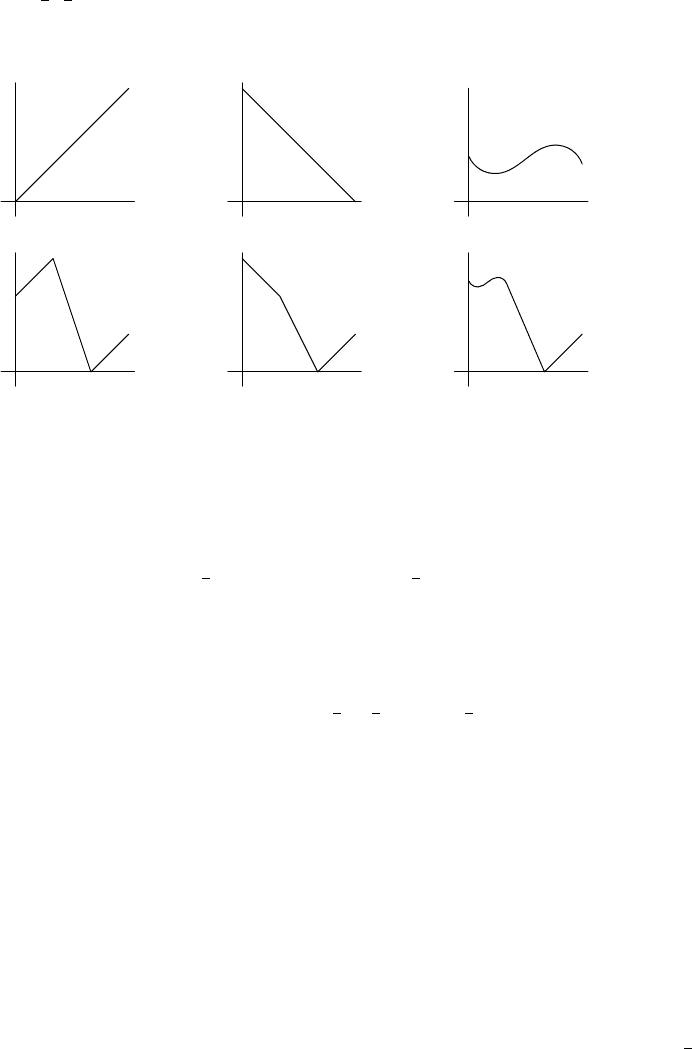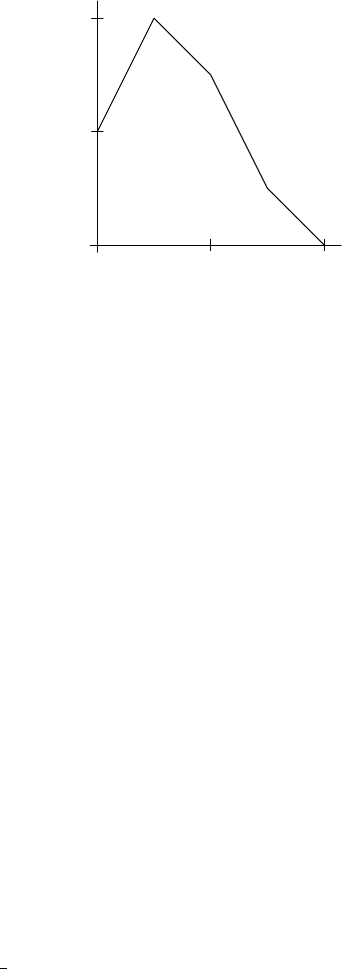Davidson K.R., Donsig A.P. Real Analysis with Real Applications
Подождите немного. Документ загружается.


11.3 Orbits of a Dynamical System 353
11.3.2. EXAMPLE. We will now look at an example that has both interesting
periodic points and transitive orbits. Some of the proofs must be left until later
(see Examples 11.5.5, 11.5.10, and 11.5.14). We shall see that this example is
chaotic. While this word is suggestive of wild behaviour, it actually has a precise
mathematical meaning which we will explore in Section 11.5.
Consider the map T from T into itself given by T θ = 2θ. This is called the
doubling map on the circle. Essentially this map wraps the circle twice around
itself. That is, the top semicircle [0, π) is mapped one-to-one and onto the whole
circle; and the bottom semicircle [π, 2π) is also mapped one-to-one and onto the
whole circle. Thus this map is two-to-one.
A point θ is periodic of period n ≥ 1 if
θ ≡ T
n
θ = 2
n
θ (mod 2π).
This happens if and only if (2
n
− 1)θ is an integer multiple of 2π. The period
of O(θ) will be the smallest positive integer k such that (2
k
− 1)θ is an integer
multiple of 2π. Thus the point
2π
2
n
−1
is periodic of period n, and
O
¡
2π
2
n
−1
¢
= {
2
j
π
2
n
−1
: 1 ≤ j ≤ n}.
Indeed, every point
2πs
2
n
−1
for every n ≥ 1 and 1 ≤ s ≤ 2
n
− 1 is a periodic point,
although the period will possibly be a proper divisor of n rather than n itself. These
points are dense in the whole circle. Because the derivative of T is 2, as a map from
R to R, it follows that every periodic point is repelling.
Also, there are eventually periodic points, namely
2πs
2
p
(2
n
−1)
for p ≥ 1. After p
iterations, these points join the periods identified previously. On the other hand, it
is not difficult to see that this is a complete list of all the periodic and eventually
periodic points. So every other point has infinite orbit. Unlike our first example,
these orbits will not converge to some period, as every periodic point is repelling.
This example also has a dense set of transitive points, although we only outline
the argument. Write a point θ as 2πt for 0 ≤ t < 1. Then write t in binary as
t = (0.ε
1
ε
2
ε
3
. . . )
base 2
. Then T
k
θ ≡ 2πt
k
(mod 2π), and the binary expansion
is t
k
= (0.ε
k+1
ε
k+2
ε
k+3
. . . )
base 2
. The possible limit points of this orbit has little
to do with the first few (say) billion coefficients. So we may use these to specify
θ close to any point in the circle. Now arrange the tail of the binary expansion to
include all possible finite sequences of 0s and 1s. Then by applying T repeatedly,
each of these finite sequences eventually appears as the initial part of the binary
expansion of t
k
. This shows that the orbit is dense in the whole circle.
Exercises for Section 11.3
A. Suppose that x
∗
is a point of period n. Show that if x
∗
is attracting (or repelling), then
each T
i
x
∗
is also an attracting (or repelling) periodic point.
B. Draw a phase diagram of the dynamics of T x = .5(x − x
3
) for x ∈ R.
C. Find the periodic points of the tripling map on the circle: T : T → T given by
T θ = 3θ.

354 Discrete Dynamical Systems
D. Consider Tx = a(x − x
3
) for x ∈ R and a > 0.
(a) Find all fixed points. Decide if they are attracting or repelling.
(b) Find all points of period 2.
HINT: First look first for solutions of T x = −x. To factor T
2
x − x, use the
fact that each fixed point is a root to factor out a cubic, and factor out a quadratic
corresponding to the period 2 cycle already found.
(c) Decide if the period 2 points are attracting or repelling.
(d) Find the three bifurcation points corresponding to the changes in the period 1 and 2
points (i.e., at which values of the parameter a do changes in the dynamic occur?).
(e) Draw a phase diagram of the dynamics for a = 2.1.
E. Consider the tent map T of [0, 1] onto itself by T x =
(
2x if 0 ≤ x ≤
1
2
2 − 2x if
1
2
≤ x ≤ 1.
(a) Graph T
n
for n = 1, 2, 3, 4.
(b) Using the graph, show that there are exactly 2
n
points which are fixed for T
n
. How
are they distributed?
(c) Use (b) to show that the periodic points are dense in X.
(d) Show that there are two distinct orbits of period 3.
HINT: Solve T
3
x = x for x ∈ [
1
8
,
1
4
] and for for x ∈ [
1
4
,
3
8
].
(e) Show that there are points of period n for every positive integer n.
(f) Find all points that are not fixed but are eventually fixed. Show that they are also
dense in X.
F. Let ω(x) =
T
n≥0
O(T
n
x) be the cluster set of the forward orbit of T .
(a) Show that T maps ω(x) into itself.
(b) Show that O(x) = O(x) ∪ ω(x).
(c) Show by example that ω(x) can be empty.
(d) If O(x) is compact, show that ω(x) is a nonempty subset of O(x).
G. Suppose that O(x) is compact.
(a) Let n
0
be the smallest integer such that T
n
0
x ∈ ω(x). Prove that
O(T
n
0
x) = ω(x) = ω(T
n
0
x).
(b) If ω(x) is infinite, show that it must be perfect. This contradicts Exercise 4.4.L.
(c) Show that O(x) is a compact set if and only if there is an n
0
so that T
n
0
x is periodic.
H. A dynamical system (X, T ) is minimal if the only nonempty closed subset F of X
such that T F ⊂ F is X itself.
(a) Show that (X, T ) is minimal if and only if every point in X is transitive.
(b) Show that the rotation R
α
on the circle T is minimal if and only if α/2π is irra-
tional.
I. Let C be the Cantor set, and represent each point x ∈ C in its ternary expansion using
only 0s and 2s. Define T : C → C by
T 0.
k−1
z
}|{
2. . . 20ε
k+1
ε
k+2
··· = 0.
k−1
z
}|{
0. . . 02ε
k+1
ε
k+2
. . .
and T 0.22222··· = 0.00000. . . .
(a) Prove that T is continuous and bijective.
(b) Show that O(0) is dense in C.
(c) Prove that (C, T ) is minimal.

11.4 Periodic Points 355
11.4. Periodic Points
In this section, we will show that the Intermediate Value Theorem is a pow-
erful tool for establishing the existence of fixed points and periodic points. This
theorem does not generally yield a computational scheme. So the conclusions of
the Contraction Principle are stronger. However, this new technique applies more
widely.
First, we look at a couple of situations that imply a fixed point.
11.4.1. LEMMA. Suppose that T is a continuous function of a closed bounded
interval I = [a, b] into itself. Then T has a fixed point.
PROOF. Consider the function
f(x) = T x − x for a ≤ x ≤ b.
Notice that
f(a) = T a − a ≥ 0
f(b) = T b − b ≤ 0.
By the Intermediate Value Theorem (Theorem 5.6.1), it follows that there is a point
x
∗
in [a, b] such that
0 = f (x
∗
) = T x
∗
− x
∗
.
Thus x
∗
is the desired fixed point. ¥
The second result is very similar, but instead of mapping an interval into itself,
we have an interval mapping onto itself.
11.4.2. LEMMA. Let T be a continuous function on a closed bounded interval
I = [a, b] such that T (I) contains I. Then T has a fixed point.
PROOF. Again consider the function f(x) = T x−x for a ≤ x ≤ b. By hypothesis,
there are points c and d such that T c = a and T d = b. Thus
f(c) = T c − c = a − c ≤ 0
f(d) = T d − d = b − d ≥ 0.
Again the Intermediate Value Theorem implies that there is a point x
∗
in [c, d] such
that
0 = f (x
∗
) = T x
∗
− x
∗
.
So x
∗
is the desired fixed point. ¥
11.4.3. EXAMPLE. Consider the family of quadratic maps Q
a
x = a(x − x
2
)
for a > 1 known as the logistic functions. These maps are inverted parabolas with
zeros at 0 and 1 and a maximum at (
1
2
,
a
4
). Each map Q
a
takes positive values on
[0, 1] and negative values elsewhere. The derivative is Q
0
a
(x) = a(1 − 2x). It is

356 Discrete Dynamical Systems
evident that |Q
0
a
(x)| > 1 on R \ [0, 1]. So it is not difficult to show that if x < 0 or
x > 1, then Q
n
a
x converges to −∞. For this reason, we restrict our domain to the
interval I = [0, 1].
There are two cases. Suppose that a ≤ 4. Then Q
a
maps I into itself. Thus
it has a fixed point by Lemma 11.4.1. On the other hand, if a ≥ 4, then since
Q
a
0 = 0 and Q
a
1
2
=
a
4
≥ 1, it follows from the Intermediate Value Theorem that
Q
a
(I) contains I. So Q
a
has a fixed point by Lemma 11.4.2.
It will be an added convenience, when the image of one interval contains an-
other, to find a smaller interval that exactly maps onto the target interval. While this
is intuitively clear, the details need to be checked. The proof is left as an exercise.
11.4.4. LEMMA. Let T be a continuous function on a closed bounded interval
I = [a, b] such that T (I) contains an interval J = [c, d]. Then there is a (smaller)
interval I
0
= [a
0
, b
0
] contained in I such that T (I
0
) = J and T ({a
0
, b
0
}) = {c, d}.
We will write I → J to indicate that T(I) contains J. Let us see how this can
be used to discover periodic points.
11.4.5. EXAMPLE. Consider the family of logistic functions Q
a
x = a(x −x
2
)
acting on I = [0, 1] for a ≥ 4. Write I
0
= [0,
1
2
] and I
1
= [
1
2
, 1]. By the argument
in the previous example, Q
a
(I
0
) and Q
a
(I
1
) both contain I (i.e., I
0
→ I
0
∪ I
1
and
I
1
→ I
0
∪ I
1
).
In particular, I
0
→ I
0
→ I
1
→ I
0
. Use Lemma 11.4.4 repeated as follows.
First find an interval J
2
⊂ I
1
such that Q
a
(J
2
) = I
0
. Then find J
1
⊂ I
0
such that
Q
a
(J
1
) = J
2
. Finally, find J
0
⊂ I
0
such that Q
a
(J
0
) = J
1
. Then
Q
3
a
(J
0
) = Q
2
a
(J
1
) = Q
a
(J
2
) = I
0
.
By Lemma 11.4.1, Q
3
a
has a fixed point in J
0
, say x
0
. We will show that this
point has period 3. Indeed, let x
1
= Q
a
x
0
and x
2
= Q
a
x
1
. By construction,
Q
a
x
2
= Q
3
a
x
0
= x
0
. Thus x
0
is either a period 3 point or a fixed point. Now x
0
and x
1
belong to I
0
and x
2
belongs to I
1
. If x
0
were a fixed point, it would belong
to I
0
∩ I
1
= {
1
2
}. But Q
a
1
2
=
a
4
≥ 1 is not fixed or even periodic. Thus x
2
is
different from x
0
and x
1
, and consequently Q
a
has an orbit of length 3.
This proof requires a ≥ 4 to work. However, it is actually the case that period
3 orbits begin to appear when a ≈ 3.8284.
11.4.6. EXAMPLE. Period doubling. Let f be a map from I = [0, 1] into
itself. Define a map Df as follows:
Df(x) =
2
3
+
1
3
f(3x) for 0 ≤ x ≤
1
3
(2 + f(1))(
2
3
− x) for
1
3
≤ x ≤
2
3
x −
2
3
for
2
3
≤ x ≤ 1.

11.4 Periodic Points 357
We claim that with the single exception of a repelling fixed point in the interval
I
2
= [
1
3
,
2
3
], the periodic orbits of Df correspond to the periodic orbits of f, the
periods are exactly double, and the dynamics (attracting or repelling) of these orbits
are preserved.
x
y
y = f(x)
x
y
y = Df(x)
x
y
y = g(x)
x
y
y = Dg(x)
x
y
y = h(x)
x
y
y = Dh(x)
FIGURE 11.7. Applying D to various functions.
Indeed, it is clear from the graphs in Figure 11.7 that there is (an easily com-
puted) fixed point in the interval I
2
. As the function Df has slope −2−f(1) ≤ −2,
this evidently is a repelling fixed point. Any other point in I
2
is mapped further and
further from this point until it leaves this middle third.
The interval I
1
= [0,
1
3
] is mapped into I
3
= [
2
3
, 1] and I
3
is mapped bijectively
onto I
1
. These orbits map back and forth between I
1
and I
3
, never intersecting I
2
.
Since no orbit, other than the fixed point, stays in I
2
, eventually every orbit (other
than the fixed point) alternates between I
1
and I
3
.
Now notice that if x ∈ [0, 1], then
(Df)
2
(x/3) = Df (
2
3
+
1
3
f(x)) =
1
3
f(x).
This means that the graph of (Df)
2
on I
1
is identical to the graph of f on I except
that it is scaled (in both the x-direction and the y-direction) by a factor of one
third. To make this precise, let σ(x) = x/3 be a map of I onto I
1
. This map is a
continuous bijection with continuous inverse σ
−1
(x) = 3x. The relation between
f and (Df )
2
can be expressed as
σf(x) = (Df)
2
σ or (Df)
2
= σfσ
−1
.
In Section 11.6, we will see that this relationship is a special case of an important
notion, topological conjugacy.
So if x is a periodic point for f of period n, then x/3 has period n for (Df )
2
and vice versa. Since Df flips back and forth between I
1
and I
3
, it follows that x/3
has period 2n for Df . Moreover, it will be attracting or repelling as x is.
Now consider a map f
0
with a unique attracting fixed point like f
0
(x) =
1
3
.
Define a sequence of functions by
f
n+1
= Df
n
for all n ≥ 1.

358 Discrete Dynamical Systems
Then f
1
has an attracting orbit of period 2 and has a repelling fixed point in be-
tween. The function f
2
will have an attracting orbit of period 4, and in between,
there will be a repelling orbit of period 2 and a repelling fixed point. Recursively
we find that f
n
has an attracting orbit of period 2
n
and in between it has repelling
orbits of lengths 1, 2, . . . , 2
n−1
.
Exercise 11.4.H outlines how to show that this sequence of functions converges
uniformly to a function f
∞
that has one repelling orbit of period 2
n
for each n ≥ 0
and no other periods.
11.4.7. EXAMPLE. The behaviour of the sequence f
n
is demonstrated dramati-
cally by the quadratic family of logistic functions Q
a
(x) = a(x−x
2
) on I = [0, 1].
When a > 1, there are two fixed points: a repelling fixed point at 0 and another
fixed point at 1 −
1
a
. The derivative
Q
0
a
(1 −
1
a
) = a
¡
1 − 2(1 −
1
a
)
¢
= 2 − a
lies in (−1, 1) for 1 < a < 3, and so 1 −
1
a
is an attractive fixed point. At a = 3,
Q
0
3
(
2
3
) = −1. This point is neither attracting nor repelling. Finally, for a > 3, the
fixed point 1 −
1
a
is repelling since Q
0
a
(1 −
1
a
) < −1.
Exercise 11.4.F considers points of period 2. Notice that
Q
2
a
x = a
¡
ax(1 − x)
¢¡
1 − ax + ax
2
¢
is a polynomial of degree 4. To find these points of period 2, solve the identity
Q
2
a
x = x. This is made easier because we already know that 0 and 1 −
1
a
are
solutions. So we may factor x and a
¡
x−(1−
1
a
)
¢
=
¡
ax−(a−1)
¢
out of Q
2
a
x−x
to obtain
Q
2
a
x − x = x
¡
ax − (a − 1)
¢¡
a
2
x
2
− (a
2
+ a)x + (a + 1)
¢
.
The quadratic factor has discriminant
(a
2
+ a)
2
− 4a
2
(a + 1) = a
4
− 2a
3
− 3a
2
= a
2
¡
(a − 1)
2
− 4
¢
.
This is positive precisely when a > 3. So for 1 < a < 3, there are no period 2
points. At a = 3, Q
2
a
x − x = x(3x − 2)
3
also has no period 2 orbits. However,
once a > 3, a period 2 orbit appears consisting of the points
p
±
=
a
2
+ a ± a
p
(a − 1)
2
− 4
2a
2
.
When a parametric family of maps changes its dynamical behaviour, this is called
a bifurcation.
To compute the derivative of Q
2
a
at p
±
, we use the chain rule
(Q
2
a
)
0
(p
+
) = Q
0
a
(Q
a
p
+
) Q
0
a
(p
+
) = Q
0
a
(p
−
) Q
0
a
(p
+
)
= a(1 − 2p
−
)a(1 − 2p
+
)
= a
2
− 2a
2
(p
−
+ p
+
) + 4a
2
(p
−
p
+
)
= a
2
− 2(a
2
+ a) + 4(a + 1)
= 5 − (a − 1)
2
.

11.4 Periodic Points 359
It follows that this period is attracting for 3 < a < 1+
√
6. Then another bifurcation
occurs at a = 1 +
√
6 when this becomes a repelling orbit. It turns out that at this
point, an attracting orbit of period 4 appears.
However, the story does not stop here. An infinite sequence of bifurcations
occurs at which point an attractive period of length 2
n
appears and the period of
length 2
n−1
becomes repelling. This is sometimes called the period doubling route
to chaos. The limit of this procedure is a point a
∞
≈ 3.5699. For every a ≥ a
∞
,
Q
a
has repelling orbits of period 2
n
for all n ≥ 0. However, the story continues
and yet more bifurcations happen between a
∞
and 4. For example, period 3 orbits
first appear at about 3.8284.
There is an ordering among the possible periods of orbits that was discovered
by Sharkovskii. In this ordering, the existence of a period n orbit implies the exis-
tence of all periods that occur later in the ordering:
3 B 5 B 7 B 9 B . . . B 6 B 10 B 14 B . . . B 12 B 20 B 28 B . . .
B 3 · 2
n
B 5 · 2
n
B 7 · 2
n
B . . . B 3 · 2
n+1
B 5 · 2
n+1
B 7 · 2
n+1
B . . .
B . . . . . . B 2
n
B 2
n−1
. . . B 4 B 2 B 1.
We will prove the special case of this result, which shows that period 3 is
preeminent among all periods. The more complicated general argument follows
the same basic lines.
11.4.8. LEMMA. Let T be a continuous map from an interval I into itself.
Suppose that there are intervals such that
I
1
→ I
2
→ ··· → I
n
.
Then there are intervals J
k
⊂ I
k
for 1 ≤ k ≤ n − 1 so that T (J
k
) = J
k+1
for
1 ≤ k ≤ n − 2 and T J
n−1
= I
n
.
PROOF. This is an easy application of Lemma 11.4.4. Using this lemma, find
J
n−1
⊂ I
n−1
such that T (J
n−1
) = I
n
. Then use the lemma again to obtain an
interval J
n−2
⊂ I
n−2
such that T (J
n−2
) = J
n−1
. Proceed in this way to define the
whole sequence. ¥
11.4.9. SHARKOVSKII’S THEOREM.
Suppose that T is a continuous map of an interval I = [a, b] into itself that has an
orbit of period 3. Then T has an orbit of period n for every n ≥ 1.
PROOF. Let x
1
< x
2
< x
3
be the period 3 orbit. Either T x
1
= x
2
or T x
1
= x
3
.
But in the second case, we may consider the interval with order reversed, in which
case x
3
is the smallest, and it maps to the second point x
2
. So the argument for the
first case must equally apply in the second. Thus we may assume that
x
1
< x
2
= T x
1
< x
3
= T x
2
and T x
3
= x
1
.

360 Discrete Dynamical Systems
Let I
0
= [x
1
, x
2
] and I
1
= [x
2
, x
3
]. Then it is evident that T I
0
contains I
1
and
T I
1
contains I
0
∪I
1
. That is, I
0
→ I
1
and I
1
→ I
0
and I
1
→ I
1
. By Lemma 11.4.4,
there is an interval J
0
contained in I
0
and there are intervals J
1
and J
2
contained in
I
1
such that
T (J
0
) = I
1
T (J
1
) = I
0
and T (J
2
) = I
1
.
For n = 1, we may invoke Lemma 11.4.1 to obtain a fixed point a
1
.
And for n = 2, we may use the fact that J
0
→ J
1
→ J
0
. From this it follows
that T
2
(J
0
) contains J
0
. So by Lemma 11.4.2, there is a fixed point a
2
of T
2
in
J
0
. We note that if J
0
∩ J
1
is nonempty, it must consist only of the point x
2
. Since
T
2
x
2
= x
1
, it is not fixed for T
2
. Thus a
2
is some other point in J
0
. This means
that T a
2
6= a
2
. Hence a
2
has period 2.
Now consider n ≥ 4. We will proceed as in Example 11.4.5. Notice that
J
0
→ J
2
→ ··· → J
2
|
{z }
n−2 copies
→ J
1
→ J
0
.
Use Lemma 11.4.8 to find intervals K
0
⊂ J
0
, K
i
⊂ J
2
for 1 ≤ i ≤ n − 2 and
K
n−1
⊂ J
1
so that
T (K
i
) = K
i+1
for 0 ≤ i ≤ n − 2 and T (K
n−1
) = J
0
.
In particular, T
n
(K
0
) = J
0
contains K
0
. Applying Lemma 11.4.2 again yields a
fixed point a
n
of T
n
in K
0
.
We must verify that a
n
has no smaller period. But this is a consequence of a
fact guaranteed by our construction:
T
i
a
n
∈ J
2
for 1 ≤ i ≤ n − 2 and T
n−1
a
n
∈ J
1
.
CLAIM: None of these points is equal to a
n
. Indeed, as in the period 2 case, the
only possible intersection of J
0
and J
1
∪J
2
is the point x
2
. However, were a
n
= x
2
,
it would follow that J
2
would be an interval containing T
2
a
n
= x
1
, which is not
possible. Hence the period of a
n
is exactly n. ¥
Exercises for Section 11.4
A. Find a continuous function from (0, 1) onto itself with no fixed points. Why does this
not contradict Lemma 11.4.1 or 11.4.2?
B. Prove Lemma 11.4.4. HINT: Pick a
0
and b
0
in [a, b] such that T a
0
= c and T b
0
= d.
If a
0
< b
0
, let a
0
= sup{x ∈ [a
0
, b
0
] : T x = c} and b
0
= inf{x ∈ [a
0
, b
0
] : T x = d}.
Consider the case a
0
> b
0
separately.
C. Consider the function T mapping I = [0, 4] onto itself by
T x =
2x + 2 for 0 ≤ x ≤ 1
5 − x for 1 ≤ x ≤ 2
7 − 2x for 2 ≤ x ≤ 3
4 − x for 3 ≤ x ≤ 4.
Figure 11.8 gives the graph of T . Note that {0, 2, 3, 1, 4} is a period 5 orbit.
(a) Sketch the graphs of T
2
and T
3
.

11.4 Periodic Points 361
x
2 4
y
2
4
y = T (x)
FIGURE 11.8. The graph of T .
(b) Show that T has one period 2 orbit.
(c) Show that T has no period 3 orbit. HINT: Show that T
3
x > x on [0, 2], T
3
x < x
on [3, 4] and T
3
is monotone decreasing on [2, 3].
D. Suppose that T is a continuous map from an interval I into itself. Moreover, suppose
that there are points x
1
< x
2
< x
3
< x
4
such that T x
1
= x
2
, T x
2
= x
3
, T x
3
= x
4
and T x
4
≤ x
1
. Show that T has an orbit of period 3.
HINT: Let I
k
= [x
k
, x
k+1
]. Show that I
1
→ I
2
→ I
3
→ I
1
.
E. Give an example of a map with an orbit of period 6, but no odd orbits.
F. Consider the logistic map Q
a
x = a(x − x
2
) for a > 1.
(a) Show that Q
a
has two fixed points in [0, 1]. Are they are attracting or repelling?
(b) What is the orbit behaviour of points in R \ [0, 1]?
(c) Compute Q
2
a
x. Look for an orbit of period 2 by solving the quartic polynomial
equation Q
2
a
x = x. Use the fact that fixed points of Q
a
are also fixed points of Q
2
a
to find two of the roots. For which values of a does Q
a
have points of period 2?
(d) Show that if the period 2 orbit is {c, d}, then (Q
2
a
)
0
(c) = (Q
2
a
)
0
(d) = Q
0
a
(c)Q
0
a
(d).
For which values of a is this period attracting? or repelling?
G. This is a computer experiment for the family of logistic maps Q
a
.
(a) Let a = 3.46. Use a computer to calculate x = Q
100
a
(.5). Then compute Q
a
x,
Q
2
a
x, Q
3
a
x, . . . , Q
10
a
x. What do you observe? Why did this happen?
(b) Try this for a = 3.55. What is different now? What bifurcation occurred?
(c) Do the same for a = 3.83. What do you observe? Try this for a = 3.8 and a = 3.9.
The two sequences do not behave in the same way, but the reasons are different.
H. Consider the period doubling method of Example 11.4.6. Start with the constant func-
tion f
0
(x) =
1
3
. Define a sequence of functions by f
n+1
= D f
n
for n ≥ 0.
(a) Show that f
n+1
(x) = f
n
(x) for all 3
−n
≤ x ≤ 1 and 1−3
−n
≤ f
n
(x) ≤ 1 for all
0 ≤ x ≤ 3
−n
.
(b) Use part (a) to show that the sequence f
n
converges uniformly to a continuous limit
function f
∞
.
(c) Calculate the point x
n
of intersection between the line y = 1 − 3
−n
+ x and the
graph of f
n+1
(x). Show that this is a point of period 2
n
for f
∞
.
(d) Show that these are the only periods of the function f
∞
.
362 Discrete Dynamical Systems
11.5. Chaotic Systems
In this section, we will define and examine chaotic systems, which are systems
of striking complexity with seemingly “wild” behaviour. The surprise is that this
complexity arises in seemingly simple situations, as the examples of this section
will show. In mathematical physics, it was an important insight that very sim-
ple, commonly occurring differential equations exhibit chaotic behaviour. Part of
the definition of chaos is that very small perturbations in initial conditions lead to
wildly different orbits. For example, this phenomenon makes detailed weather pre-
diction over the long term impossible, even if it is weather produced in a laboratory
using an apparently simple model. This is also the reason that water flowing in a
river produces complicated eddying that is constantly changing and unpredictable.
The mathematical notion of chaos depends on three things. The first is a dense
set of periodic points. The other two items are new, and we study each of them in
turn.
11.5.1. DEFINITION. A dynamical system T mapping a set X into itself is
topologically transitive if, for any two nonempty open sets U and V in X, there is
an integer n ≥ 1 such that T
n
U ∩ V is nonempty.
11.5.2. PROPOSITION. For a dynamical system T mapping a set X into itself,
topological transitivity is equivalent to the following: For eachx, y ∈ X and ε > 0,
there is a point z ∈ X and an integer n ≥ 1 such that
kx − zk < ε and ky − T
n
zk < ε.
PROOF. To see this, first assume T is topologically transitive. Given x, y ∈ X and
ε > 0, take U = B
ε
(x) and V = B
ε
(y). Transitivity provides n so that T
n
U ∩ V
is nonempty. Pick z ∈ U so that T
n
z ∈ V , and we are done.
Conversely, let nonempty open sets U and V be given. Pick points x ∈ U and
y ∈ V . Since U and V are open, there is an ε > 0 so that
B
ε
(x) ⊂ U and B
ε
(y) ⊂ V.
Let z and n ≥ 1 be chosen so that z ∈ B
ε
(x) and T
n
z ∈ B
ε
(y). Then T
n
z belongs
to T
n
U ∩ V . ¥
If there is a transitive point x
0
, meaning that O(x
0
) is dense in X, then T
is topologically transitive. For if x and y and ε > 0 are given, pick m so that
kx − T
m
x
0
k < ε. Notice that the orbit O(T
m
x
0
) is the same as O(x
0
) except
for the first m points, and hence it is also dense (explain this). So there is another
integer n ≥ 1 so that ky − T
m+n
x
0
k < ε. So z = T
m
x
0
does the job.
It is perhaps a surprising fact that the converse is true. We require that X is
infinite just to avoid the trivial case when X consists of a single finite orbit. The
proof depends on the Baire Category Theorem, from Section 9.3.
